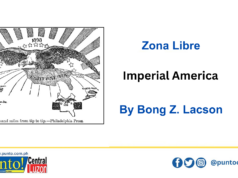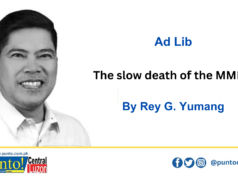TODAY IS Sunday, the 18th of April 2021, the third Sunday of Easter. It was on this day, 500 years ago, that the first baptism took place in Cebu. In 1521, the Third Sunday of Easter was on April 14. That is why the Archdiocese of Cebu celebrated their own commemoration of the First Baptism last Wednesday, April 14, 2021.
We originally intended to open the Jubilee Door of San Roque Cathedral last April 4, Easter Sunday. As agreed in the CBCP, we were supposed to do a simultaneous nationwide launching of the 500th Year of Christianity, with a commemoration of the First Mass ever to be celebrated on these islands, which was on Easter Sunday of 1521. But because the government had declared a lockdown in the so-called “NCR Bubble” and prohibited public religious gatherings last Holy Week, we decided to postpone our celebration and wait until we could be allowed even just a 10 percent maximum physical attendance in our Cathedral.
We thank the Lord that today, on the third Sunday of Easter, we are finally launching our own quincentennial celebration with the opening of the Jubilee Door of the San Roque Cathedral Parish.
When you find the occasion to visit our Cathedral physically and pass through the Jubilee Door, I invite you to take a close look at the hand-carved wooden relief panels applied on the door. They were sculpted by an artist from my hometown in Betis, Pampanga.
On the upper portion, you will see two round panels depicting the two main historical events that took place 500 years ago: on the left side, the first Mass held in Limasawa on Easter Sunday, March 31,1521, and, on the right side, the first baptism held in Cebu on third Sunday of Easter, April 14, 1521.
In the inner middle portion, aside from the symbols depicting the evangelists on the outer panels, you will see two relief panels depicting the two patrons of our Cathedral Parish: San Roque, the patron of plague victims, and Our Lady of Nieva, also known as the Virgin of the Underground.
On the lower middle portion, we added two other relief panels depicting the first two native Filipino saints, San Lorenzo Ruiz and San Pedro Calungsod. I hope you forgive us for depicting them wearing face masks, to perpetuate the memory of the terrible plague that has coincided with our celebration of the 500th Year of the Arrival of Christianity in the Philippines: the Covid 19 Pandemic.
It was on those two Sundays of Easter in 1521 that the first Christian icons were introduced to our native ancestors: the cross, which Magellan planted on a hill in Limasawa on the day the first Mass was celebrated, and the Santo Nino, which Magellan had given as gift to the wife of Humabon on the day of the first baptism in Cebu. The cross and the Santo Nino were Magellan’s tokens of friendship to the natives of Samar, Leyte and Cebu who had treated these weary travelers from Spain with kindness.
The Italian chronicler, Antonio Pigafetta tells us Magellan and his troops cautiously held on to their weapons as they approached the Visayan islands because they had earlier been treated with hostility in the first islands they had sighted in Guam. They were just passing through, trying to find their way to the Moluccas.
They had been out in the south Pacific Ocean for more than twelve months before that; they had lost one ship to a storm and had been deserted by another ship. They arrived as total strangers in uncharted waters, hungry, sick, tired, sea-beaten and in need of assistance. They were uncertain if the natives of these newfound islands would be as hostile as the ones they had encountered in Guam.
To their great surprise, the first native fishermen they encountered in Samar disarmed them with their welcoming spirit and childlike simplicity. So also did their friendly chieftains, Rajah Kolambu and his brother. These people did not seem to be afraid of strangers. They generously offered them food and drink, helped them care for their sick companions, bury their dead, and build a platform on which they could celebrate Mass on Easter Sunday, in order to offer thanksgiving.
If these Europeans were looking for gold, they were probably surprised to find it, not underground, but in the hearts of the first natives they encountered in Homonhon, Samar. They were surprised to find God in these gentle natives who they thought were savage and godless.
Magellan did not bring God to them; he found God among them. He was touched by their nobility, their compassion, warmth and hospitality. No wonder he quickly shifted from being a mercenary to behaving like a missionary, despite all his awkwardness and limited knowledge of the Christian faith himself.
What Magellan discovered in these islands which he called San Lazaro was not a colony but a fertile ground for the seeds of the Christian faith. He found it in the natives among whom he had encountered people of good will who quickly became his friends. They shared with him the best that they could offer and Magellan reciprocated them by offering what he thought was also the best he could offer, his Christian faith.
I am sure the chieftains Humabon of Cebu, Kolambu of Limasawa and their families did not exactly think of their baptism as conversion to a new religion. I am more inclined to believe that they thought of this elaborate ritual as no different from the blood compact they had earlier ritualized the native way. Obviously,Magellan did not even have enough time to catechize them. It was enough that on either side, there was the willful desire to seal a friendship that would serve as the seedbed for the Gospel.
I do not want you to think I am romanticizing the events that happened in 1521, which, in the eyes of some Filipino historians are not even worth celebrating. No doubt, the initial seeds of faith that were sown on the fertile soil of good will and friendship were soon corrupted by the bad weeds of hidden economic and political agenda.
As in the famous Matthean parable of the wheat and the tares, the good seeds eventually got sabotaged by the weeds of ill will, treachery and betrayals that led to the tragic encounter with Lapu-Lapu on April 27 in Mactan. It also resulted in the death of Magellan and several of his men, the ensuing hostility of Humabon and further casualties among the survivors of Mactan and the bitter parting of ways on May 1, 1521.
Did all of it end up in vain? Remember, these flawed human beings had merely served as God’s instruments. As the old hymn puts it, “We plough the fields and scatter the good seeds on the ground, but it is fed and watered by God’s almighty hand.” It was the Lord who made sure that whatever had germinated from the first sowing in 1521 would be nurtured to fruition by the follow-up expedition that later arrived in 1565, which brought in the first group of missionaries to these islands.
If the first icon of Jesus that was introduced to the natives of Cebu was the Santo Nino, it was also the same icon that was introduced to the natives of Luzon in one of the first parishes ever to be established by the Augustinians, the Santo Nino de Tondo. It was this mother parish that soon established little chapels called visitas in Tambobong, Malabon in 1595, and in this place in Caloocan in 1765. It might interest you to know that San Bartolome in Malabon, which became a parish in 1599 and San Roque in Caloocan, which became a parish in 1815, were both cut off from the umbilical cord of their common mother parish, the Santo Nino de Tondo.
I hope this long historical background now makes youunderstand why we had the two icons standing there by the threshold of the Jubilee Door as soon as I opened it: the Cross and the Santo Nino. You will also understand why the Santo Nino is so profoundly embedded in the consciousness of our people, as well as the cross-bearing black Nazarene.
Lastly, how does this Jubilee celebration relate to our Gospel about the disciples’ encounter with the Risen Christ? The key word that I propose is REALITY CHECK—what the Lord did to convince his disciples when he manifested his risen life to them that He was real. Two things: first, he made them touch his wounded but living body, and second, he opened their minds to understand the Scriptures.
First, he said, “Touch me and see.” This was his way of saying I am neither a ghost nor a superman. We have no illusion about the way Jesus has continued his work of redemption through real flesh and blood human beings like the first Christians whom our native ancestors first came into contact with, or even the missionaries who sustained the work of evangelization in the succeeding centuries.
God works through a Church that is both holy and sinful, divine and human. He speaks and acts through real people who love and care but who also bleed, people who fail, who fall, who are capable of doing stupid things, even as they continue to respond to the call to be sons and daughters of God.
Secondly, he continues to open minds to the realities of the world through the light of the Scriptures. The Scriptures are supposed to help us understand experience better, not run away from it. The Christian faith is never meant to teach us to escape from the world and its many challenges. On the contrary, it teaches us to confront the world head on. It is not about holding on to an illusion or an imagined heaven in the hereafter.
Many people have the tendency to equate hope with sheer optimism, as if it were a matter of thinking positive, of looking at the bright side of life and simply avoiding negativities. What Jesus reveals to us is an enduring love that gives unconditionally, that is ready to pay the price, even at the cost of so much suffering and death. He teaches us how to respond in faith so that we can see the hand of God at work even in our darkest and most painful experiences.
Perhaps this is reason why we continue to deal with this pandemic. The Covid–19 has served as a reality check not only for us Filipinos but for all humankind. It has opened our minds to the fragility of the earth and our own vulnerability. It has given us the opportunity to awaken from the stupor of our self-destruct mode and has afforded us the time to be able to reconfigure ourselves and our societies as we should.
One of the clearest and most tangible signs of hope in the midst of the hopelessness brought about by this pandemic has been going viral in the social media lately. It all began in a street in QC called MAGINHAWA, when one family invited the rest of the neighborhood to put up a community pantry, which people can both freely give to, and take from. The slogan written on the cardboard is simple: it invites people to share according to their ability and to take according to their need. This is the right cardboard sign that will forever erase the shame of the cardboards hung by killers on the thousands of people that they have killed in the past few years.
I have the joy to inform you that in partnership with Caloocan Young Leaders initiative, the San Roque Cathedral is also opening today its Community Pantry.
Within just a few days, one little experiment has multiplied itself exponentially. Please, let us not allow it to fizzle out; this is perhaps the best chain reaction I have ever heard of in this time of crisis. Remember, WE ARE GIFTED TO GIVE. Please, wherever we can, let us put up one of these community pantries. It will be a more powerful legacy of the 500th YoC than the opening of a symbolic jubilee door. Today, the Lord invites us to touch his wounded body, to heal the world by sharing our food with the hungry, and give flesh to the Good News of redemption proclaimed by the Scriptures.
May the opening of our jubilee doors throughout the country bring inspire the silent but spontaneous opening of thousands of community pantries all over the world.
(Homily for the Opening of the Jubilee Door for the 500th Year of Christianity in the Philippines, 3rd Sunday of Easter, Luke 24:35-48)





